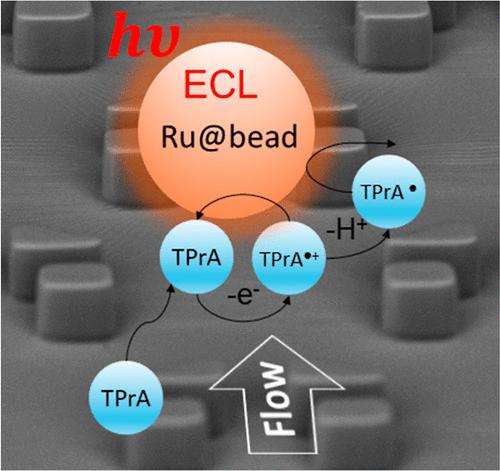Electrochemiluminescence at Functionalized Trapped Microbeads in Microfluidic Channels
IF 9.1
1区 化学
Q1 CHEMISTRY, ANALYTICAL
引用次数: 0
Abstract
Electrochemiluminescence (ECL) is successfully combined with microbead-based immunoassays for quantification of a wide range of biomarkers. Herein, a microfluidic platform was developed to study the electrochemiluminescence (ECL) emission of a model microbead-based system under controlled flow conditions. The microbeads, functionalized with tris(2,2′-bipyridine)ruthenium(II) as luminophore, were entrapped by micropillars in a microfluidic channel and exposed to a circulating solution of tri-n-propylamine coreactant. The confined space of the microchannel combined with convective mass transport allowed the enhancement of the ECL signal emitted by the entrapped beads. Analysis of the light profiles from isolated beads showed that the performance of the heterogeneous ECL pathway was greatly influenced by the flow rate. Therefore, mass transport was found to be essential for tuning the ECL intensity of these systems, as it leads to a 4-fold increase in ECL intensity from diffusive to convective regimes. These results already highlight real opportunities for improving ECL immunoassays through novel flow-based strategies.

微流控通道中功能化捕获微珠的电化学发光
电化学发光(ECL)成功地与基于微珠的免疫测定相结合,用于定量广泛的生物标志物。在此基础上,建立了一个微流控平台来研究基于微珠的模型系统在受控流动条件下的电化学发光(ECL)发射。以三(2,2 ' -联吡啶)钌(II)为发光基团的微球被微柱包裹在微流控通道中,并暴露于三正丙胺共反应物的循环溶液中。微通道的密闭空间与对流质量传输相结合,可以增强被困珠发出的ECL信号。光谱分析表明,流量对非均相ECL通路的性能有很大影响。因此,发现质量输运对于调节这些系统的ECL强度至关重要,因为它会导致ECL强度从扩散到对流增加4倍。这些结果已经强调了通过新的基于流量的策略改进ECL免疫测定的真正机会。
本文章由计算机程序翻译,如有差异,请以英文原文为准。
求助全文
约1分钟内获得全文
求助全文
来源期刊

ACS Sensors
Chemical Engineering-Bioengineering
CiteScore
14.50
自引率
3.40%
发文量
372
期刊介绍:
ACS Sensors is a peer-reviewed research journal that focuses on the dissemination of new and original knowledge in the field of sensor science, particularly those that selectively sense chemical or biological species or processes. The journal covers a broad range of topics, including but not limited to biosensors, chemical sensors, gas sensors, intracellular sensors, single molecule sensors, cell chips, and microfluidic devices. It aims to publish articles that address conceptual advances in sensing technology applicable to various types of analytes or application papers that report on the use of existing sensing concepts in new ways or for new analytes.
 求助内容:
求助内容: 应助结果提醒方式:
应助结果提醒方式:


